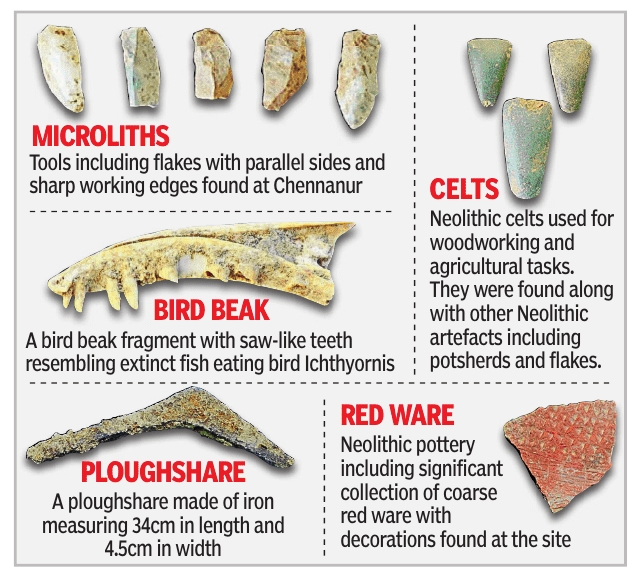Krishnagiri, history
This is a collection of articles archived for the excellence of their content. |
Antiquity
2025 findings
A Ragu Raman, Sep 14, 2025: The Times of India

From: A Ragu Raman, Sep 14, 2025: The Times of India
Chennai : A sediment sample from the Stone Age site in the hamlet of Chennanur in Tamil Nadu’s Krishnagiri district has been dated to 8,450 BCE by an Oxford University lab, providing scientific proof that people have continuously inhabited the region for at least 10,000 years — from the Microlithic period to the Chola era.
Over the past year, experts from the state archaeology department excavated the site, collecting sediment from layers that yielded Microlithic tools such as flakes, blades and quartz cores. The site also produced polished stone tools like celts, hammerstones and sling balls from the Neolithic period.
The sediment was sent to Oxford’s Luminescence Dating Laboratory, which used the optically stimulated luminescence method to arrive at the 8,450 BCE date. “The first-ever date for the later Microlithic period in Tamil Nadu has scientifically proved that this region was continuously inhabited for the last 10,000 years,” said K Rajan, academic and research adviser, TN State Department of Archaeology.
“So far, archaeologists have been saying people were living here continuously based on stratigraphy. Now, we have evidence. Further studies will reveal more about South India’s cultural development,” added archaeologist V Selvakumar of Tamil University, Thanjavur. The dating offers hope of tracing the shift from huntergatherers to agrarian communities. Lack of urbanisation and industrialisation kept the 50-acre cultural mound intact, helping archaeologists date the later Microlithic period for the first time in the state.
“The deepest layer of the excavation site has Microlithic stone tools, including flakes and blades. We can say human settlement started from the Microlithic period. A hero stone with Chola-era inscriptions was found nearby, so the site could have been continuously occupied until the 10th or 11th century, and later people might have moved out,” said S Paranthaman, who led the excavation.
Researchers found polished stone tools, charred animal bones, burnished ware and coarse red ware from the Neolithic period, indicating a gradual shift to agriculture and settled life. Iron Age remnants such as nails, rusted blades and lime-coated floors show evidence of domestic and industrial activity.
The next layer yielded potsherds of black and red ware, red slipped ware, shell bangles, terracotta figurines, glass ornaments and Tamil Brahmi-inscribed potsherds, pointing to early historic trade. Early medieval and medieval layers, though thinner, show continued occupation.
See also
Krishnagiri, history